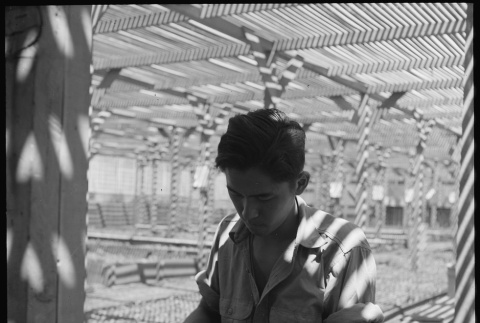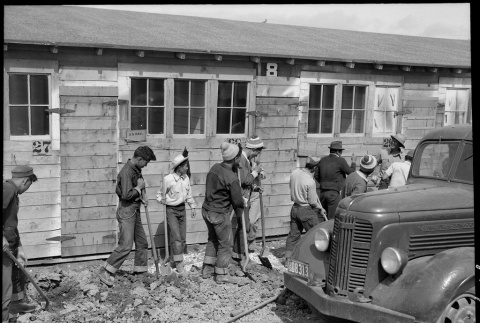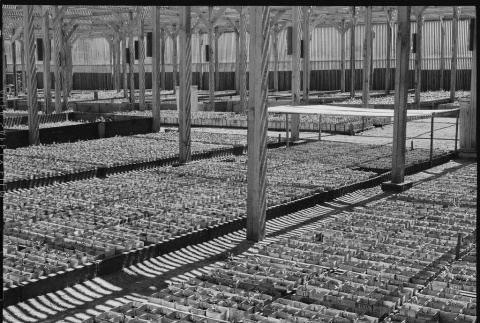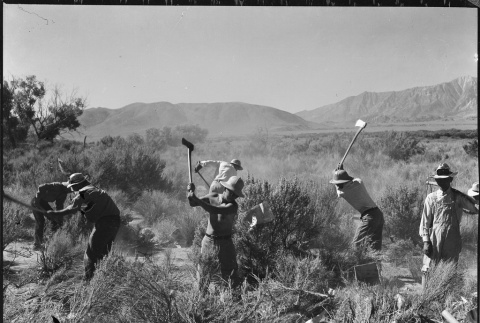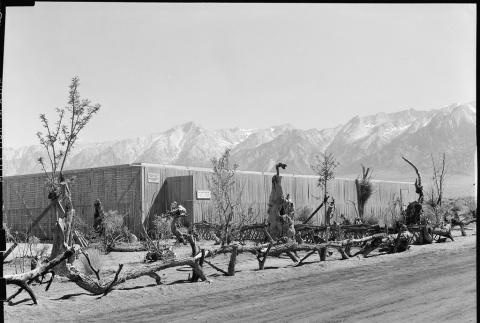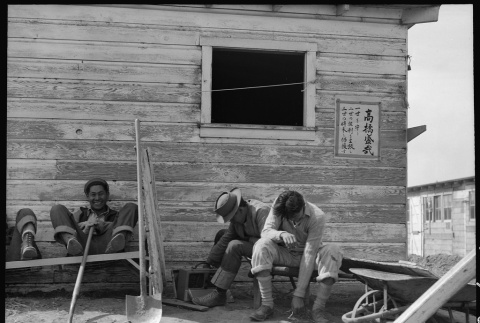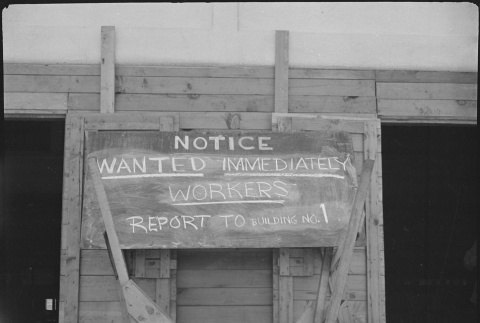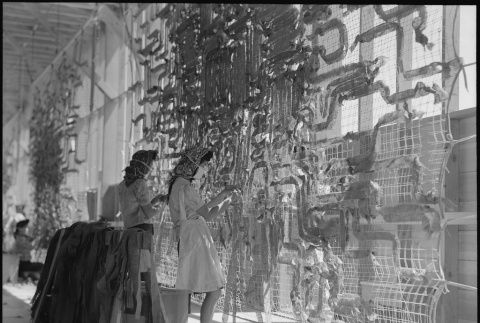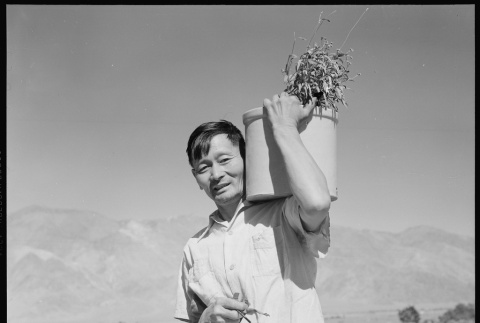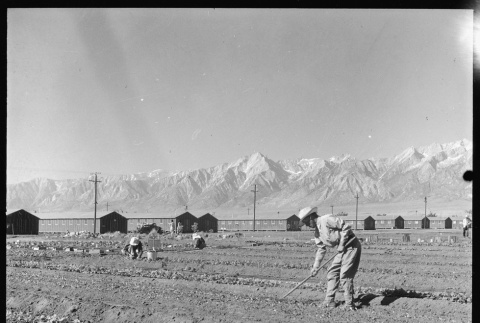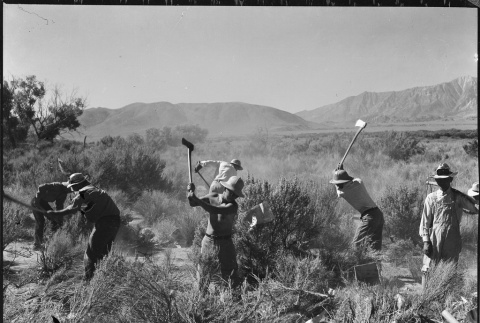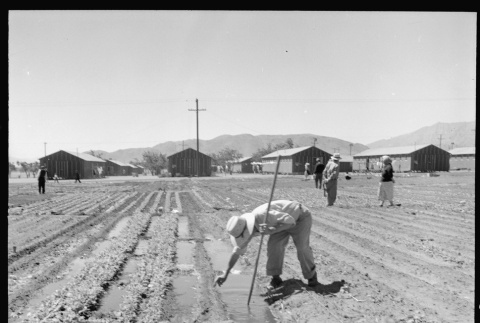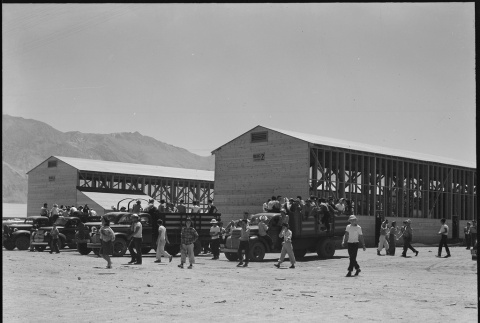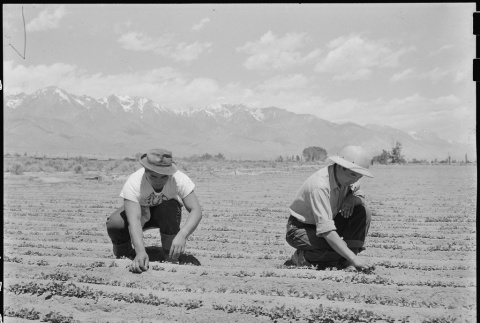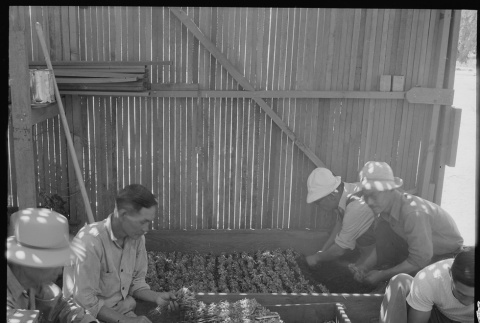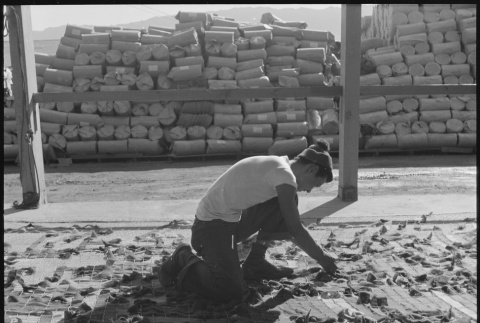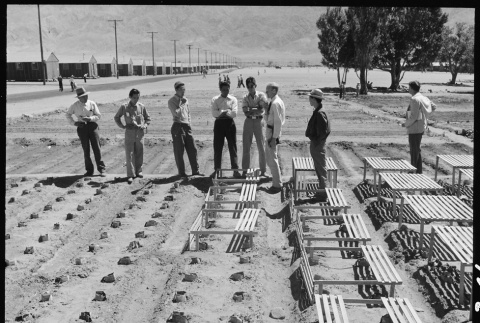Work and jobs
Both Issei and Nisei took jobs within the camps, at wages set not to exceed soldiers' pay: $12 per month for unskilled labor, $16 for skilled labor, and $19 for professional employees. WRA staff was paid much more for the same jobs. Though public opinion mandated such low pay, dissatisfied Japanese Americans objected to losing their right to make a decent living. They had to use their sparse income for necessities, such as warm clothing and shoes.
World War II
(231)
Concentration camps
(1434)
Work and jobs
(1360)
Related articles from the
Densho Encyclopedia :
Amache Silk Screen Shop
1360 items
1360 items
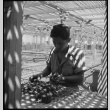
img
Japanese American working in lath house (ddr-densho-151-470)
Original caption: Manzanar Relocation Center, Manzanar, California. An evacuee is shown in the lath house sorting seedlings for tranplanting. These plants are year-old seedlings from the Salinas Experiment Station.
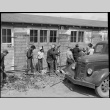
img
Japanese American workers digging a ditch (ddr-densho-151-342)
Original caption: San Bruno, California. Maintenance work, repair and construction is done by volunteer evacuee workers. The wages are $8.00 per month for 48 hours per week. This gang of boys and young men are digging a drainage tank along the front of one of the barracks.
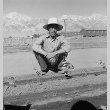
img
Japanese American in field (ddr-densho-151-375)
Original caption: Manzanar Relocation Center, Manzanar, California. Ogura Shuichi, born in Pasadena. He attended Pasadena Junior College and was a visiting student at the California Institute of Technology. He is now working as a plant statistician for the guayule rubber experiment project at this War Relocation Authority center for evacuees of Japanese ancestry.
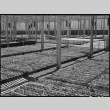
img
Guayule plants (ddr-densho-151-383)
Original caption: Manzanar Relocation Center, Manzanar, California. View of one of the lath house where seedlings are grown under controlled conditions, for the guyaule rubber experiment project.

img
Japanese Americans clearing land (ddr-densho-151-37)
Original WRA caption: Manzanar Relocation Center, Manzanar, California. More land is being cleared of sage brush at the southern end of the project to enlarge this War Relocation Authority center for evacuees of Japanese ancestry.
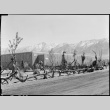
img
Lath house (ddr-densho-151-384)
Original caption: Manzanar Relocation Center, Manzanar, California. Exterior view of the lath house of guyaule rubber experiment project in which seedlings are grown under controlled conditions with a staff of 22 workers, under the direction of Walter T. Watanabe. The initial shipment of 100,000 seedlings came from the Salinas Experiment Station. Note decorative desert garden.

img
Japanese American workers resting in shade (ddr-densho-151-343)
Original caption: San Bruno, California. Time out for some of the boys on the Work Corps. All maintenance work, repair and construction is done by volunteer evacuee workers. The wages are $8.00 per month for 48 hours a week. This gang of boys and young men are digging a drainage tank along one of the barracks.

img
"Help wanted" sign (ddr-densho-151-229)
Original caption: San Bruno, California. "Help Wanted" sign displayed for newly arrived evacuees. There was much work to be done since the center was opened on the previous day. Three weeks later there were 8,000 persons of Japanese ancestry in this center.
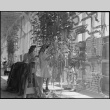
img
Japanese Americans making camouflage nets (ddr-densho-151-409)
Original caption: Manzanar Relocation Center, Manzanar, California. Making camouflage nets for the War Department. This is one of several War and Navy Department projects carried on by persons of Japanese ancestry in relocation centers.

img
Japanese Americans making camouflage nets (ddr-densho-151-411)
Original caption: Manzanar Relocation Center, Manzanar, California. Making camouflage nets for the War Department. This is one of several War and Navy Department projects carried on by persons of Japanese ancestry in relocation centers.
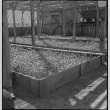
img
Guayule plants (ddr-densho-151-382)
Original caption: Manzanar Relocation Center, Manzanar, California. Guayule beds in the lath house at this War Relocation Authority center. These plants are year-old seedlings from the Salinas experiment station which are ready to be transplanted into the open ground.

img
Farm crew (ddr-densho-151-389)
Original caption: Manzanar Relocation Center, Manzanar, California. Farm crew of which Johnny Fukazawa is foreman. These men are ready to return to the center's mess hall for lunch after a busy morning in the fields of the farm project at this War Relocation Authority center.

img
Japanese American holding guayule plant (ddr-densho-151-469)
Original caption: Manzanar Relocation Center, Manzanar, California. George J. Yokomizo, hybridizer for the guyaule rubber experment project, outside the lath house with one of the guyale plants from which he hopes to develop seed.
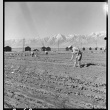
img
Japanese Americans tending crops (ddr-densho-151-35)
Original WRA caption: Manzanar Relocation Center, Manzanar, California. Evacuees of Japanese ancestry are growing flourishing truck crops for their own use in their "hobby gardens." These crops are grown in plots 10 x 50 feet between blocks of barrack at this War Relocation Authority Center.
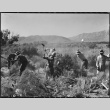
img
Japanese Americans clearing brush (ddr-densho-151-388)
Original caption: Manzanar Relocation Center, Manzanar, California. More land is being cleared of sage brush at the southern end of the project to enlarge this War Relocation Authority center for evacuees of Japanese ancestry.
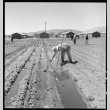
img
Japanese Americans gardening (ddr-densho-151-65)
Original WRA caption: Manzanar Relocation Center, Manzanar, California. Evacuees of Japanese ancestry are growing flourishing truck crops for their own use in their "hobby gardens". These crops are grown in plots 10 x 50 feet between blocks of barrack at this War Relocation Authority center.

img
Japanese Americans making camouflage nets (ddr-densho-151-408)
Original caption: Manzanar Relocation Center, Manzanar, California. Making camouflage nets for the War Department. This is one of several War and Navy Department projects carried on by persons of Japanese ancestry in relocation centers.

img
Japanese American examining guayule plants (ddr-densho-151-385)
Original caption: Manzanar Relocation Center, Manzanar, California. George J. Yokomizo, hybridizer for the guayule rubber experiment project.

img
Japanese Americans working in field (ddr-densho-151-445)
Original caption: Manzanar Relocation Center, Manzanar, California. Ichiro Okumura, 22 (left), from Venice, California and Ben Iguchi, 20 from Sangus, California, thin young plants in a two-acre field of white radishes at the relocation center. High sierras are shown in the background.
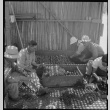
img
Japanese Americans working with guayule plants (ddr-densho-151-380)
Original caption: Manzanar Relocation Center, Manzanar, California. Guayule beds in the lath house at the Manzanar Relocation Center.

img
Japanese American working in lath house (ddr-densho-151-379)
Original caption: Manzanar Relocation Center, Manzanar, California. Guayule beds in the lath house at the Manzanar Relocation Center.
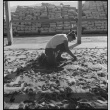
img
Japanese American making camouflage net (ddr-densho-151-412)
Original caption: Manzanar Relocation Center, Manzanar, California. Making camouflage nets for the War Department. This is one of several War and Navy Department projects carried on by persons of Japanese ancestry in relocation centers.
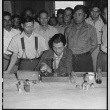
img
Japanese Americans experimenting with guayule (ddr-densho-151-387)
Original caption: Manzanar Relocation Center, Manzanar, California. Chemists, nurserymen, and plant propagators at this War Relocation Authority center assemble to witness a new experiment in an attempt to resolve the amount of rubber produced in a small quantity of the guayule plant. Frank Hirosawa, research rubber chemist, is seated in the foreground.
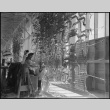
img
Japanese Americans making camouflage nets (ddr-densho-151-55)
Original WRA caption: Manzanar Relocation Center, Manzanar, California. Making camouflage nets for the War Department. This is one of several War and Navy Department projects carried on by persons of Japanese ancestry in relocation centers.
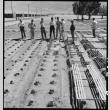
img
Japanese Americans inspecting guayule plants (ddr-densho-151-381)
Original caption: Manzanar Relocation Center, Manzanar, California. Guayule plantings are being inspected by Doctor Robert Emerson, (third from right) a bio-chemist and botanist from the California Institute of Technology and director of the guayule rubber experiment. He is here shown conferring with several of his staff of young evacuee scientists at Plot 4. There are 408 …
